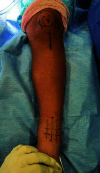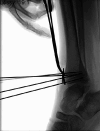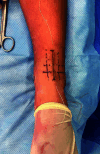Anterior Hemiepiphysiodesis of the Distal Tibia: A Step-by-step Surgical Technique Guide
- PMID: 38404566
- PMCID: PMC10891351
- DOI: 10.5005/jp-journals-10080-1596
Anterior Hemiepiphysiodesis of the Distal Tibia: A Step-by-step Surgical Technique Guide
Abstract
Aim: This paper aims to serve as a guide for surgeons to prepare, execute, and perfect anterior hemiepiphysiodesis of the distal tibia (AHDT).
Background: Treatment of persistent or recurrent equinus deformity following multiple conservative and surgical interventions in patients with idiopathic clubfoot or neuromuscular conditions can be challenging, and multiple surgical options are presented in the existing literature. Anterior hemiepiphysiodesis of the distal tibia is an option that seems to be safe and efficient in treating this entity. To the best of our knowledge, there is not yet any detailed description of this surgical technique in the English literature.
Technique: The AHDT detailed surgical technique includes patient positioning, careful distal anterior tibial approach, placement of guided growth plates, fixation with epiphyseal and metaphyseal screws under fluoroscopic guidance, meticulous closure, and postoperative measures.
Conclusion: This guide can be used pre-operatively to plan the surgery, intra-operatively to aid in smooth and safe step progression, and post-operatively to assist in critical critiquing.
Clinical significance: By understanding the various stages of the surgery as well as the anatomy, pitfalls can be avoided and AHDT can be performed efficiently.
How to cite this article: Katz A, Dumas É, Hamdy R. Anterior Hemiepiphysiodesis of the Distal Tibia: A Step-by-step Surgical Technique Guide. Strategies Trauma Limb Reconstr 2023;18(3):174-180.
Keywords: Ankle; Clubfoot; Equines; Guided growth; Surgical anatomy; Tibia.
Copyright © 2023; The Author(s).
Conflict of interest statement
Source of support: Nil Conflict of interest: None
Figures



















References
-
- Giertych BF, Galli SH, Halanski MA, et al. “Anterior hemi-epiphysiodesis of the distal tibia for residual equinus deformity in children with clubfeet.”. Journal of the Pediatric Orthopaedic Society of North America. 2022;4(1):1–11. doi: 10.55275/JPOSNA-2022-0004. - DOI
LinkOut - more resources
Full Text Sources

